Menu
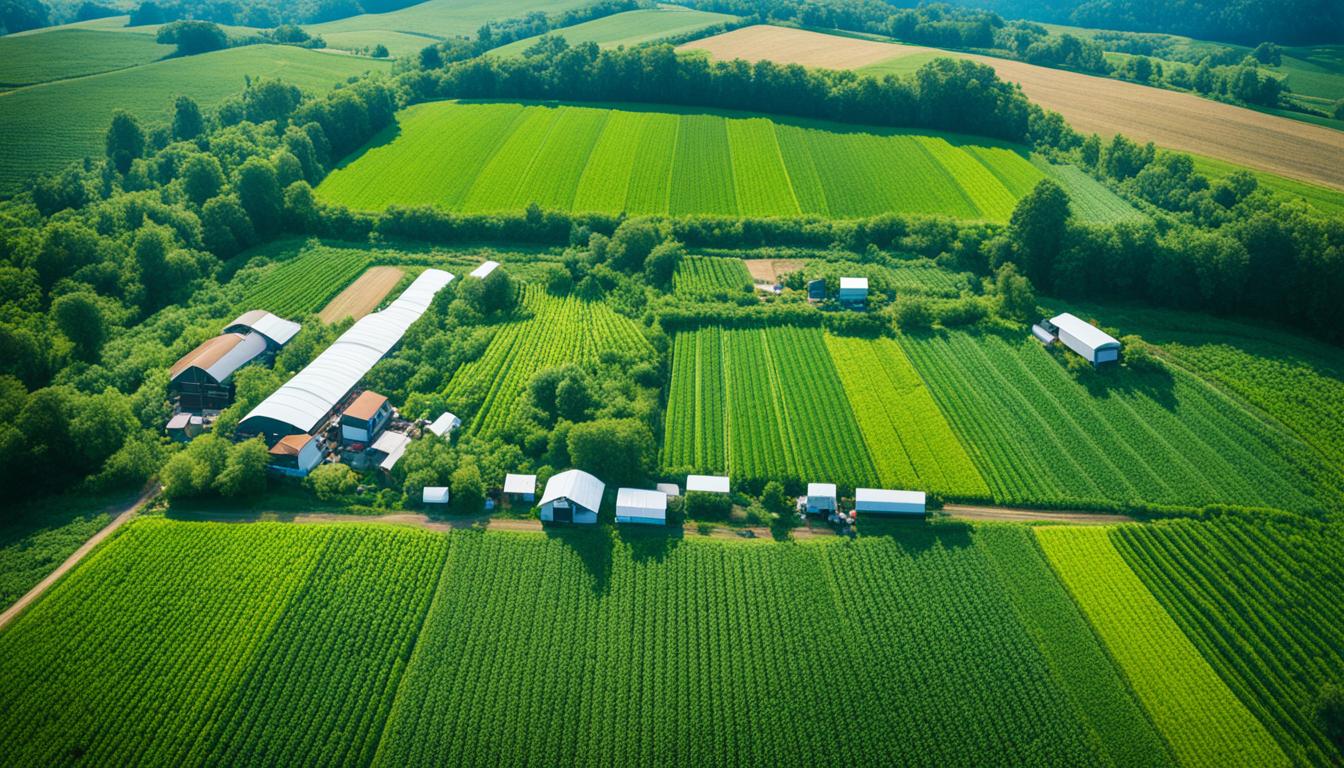
Did you know you can shop digitally 24/7 with FBN Direct®? Technology is changing everything, including farm work. I started focusing on sustainable farming due to the world’s growing concern about emissions. Big names like Mars, Inc and Nestlé® are promising to cut emissions. This shows how important these changes are for our future trade.
Farmers are now aiming to produce high quality with low emissions, as demanded by customers and national targets, like a 10% methane cut by 2030. This makes boosting farm efficiency crucial to keep farms running well. We need to pay attention to how we farm each season. It’s about using new tech and green methods to meet these stricter standards.
Seasonal farm efficiency is a key part of today’s farming. It helps sustainable agriculture practices and the need to lower impacts on our planet. Getting the most out of farming each season uses resources better. It also helps reach higher sustainability goals worldwide. Farming smarter involves many different methods.
The USDA has started a new plan to save energy on farms. This initiative guides farmers to work more efficiently. The Michigan State University Dairy Facility has even won an award for being energy-smart. It shows that U.S. farming can lead in sustainability and efficiency.
Guides on how to manage high-temperature grain dryers are now available. They help farmers use energy better. This is key for making the most of each season. Online talks on making pigs comfortable, saving energy, and boosting profits offer useful advice. They support sustainable farming.
Advisory updates on picking energy-saving fans for swine farms are also out there. They remind farmers to think about saving energy daily. Following these tips can boost a farm’s performance. It also helps the environment. This is good for the whole farm’s future.
To sum up, seasonal farm efficiency mixes many plans to increase both productivity and care for the Earth. It’s about keeping farms strong and green for the future.
Sustainable agriculture practices are crucial for dealing with environmental issues. They work to keep our planet healthy. These methods focus on three aims: looking after the land, making money, and fairness for all. Supporting our earth’s soil, using less water, and lowering pollution levels help farmers be more eco-friendly.
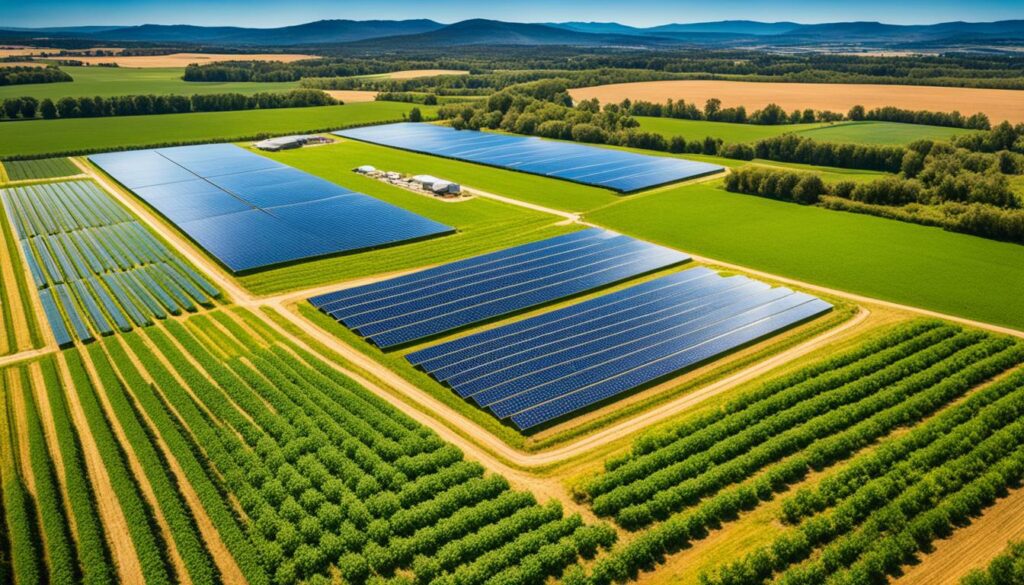
It’s key to cut down on emissions for sustainable farming and to fight climate change. Methane emissions are a big problem. People and governments are pushing to meet environmental goals. They look at all emissions across the entire supply chain. Companies like Nestlé® and Fonterra™ are serious about sticking to tough environmental rules.
Eco-friendly farming methods, besides cutting emissions, have big pluses. Things like changing which crops you plant, growing trees with crops, and not ploughing too deep help. Mixing up crops can make soil healthier by 20% and cut the need for chemicals by 30%. Also, smarter ways to deal with pests have dropped pesticide use a lot but kept things under control. These methods are good for the environment and make farms do better in terms of money.
| Practice | Benefit | Impact |
|---|---|---|
| Crop Rotation | Increases Soil Health | 20% Increase |
| Conservation Tillage | Improves Yield | 10% Increase |
| Integrated Pest Management | Reduces Pesticide Use | 70% Reduction |
| Agroforestry | Increases Biodiversity | 30% Increase |
Productive farming needs key steps for the best results. This includes making crops grow well and keeping the ground healthy. By doing this, farms work better and help protect nature.
Making crops perform their best is key for farmers. They do this by picking the best seeds, planting well, and watering smartly. This way, they get more from their work, which also means they earn more.
The health of the soil and what it eats are vital for farming well. Farmers can keep the soil good by rotating crops, adding natural matter, and not disturbing it too much. This helps their land stay fertile and strong against bad environmental conditions.
Today, tech is key in making farming better and more accurate. With tools like Climate FieldView and satellite guidance, farmers see big improvements. They get better at using resources and make more crops.
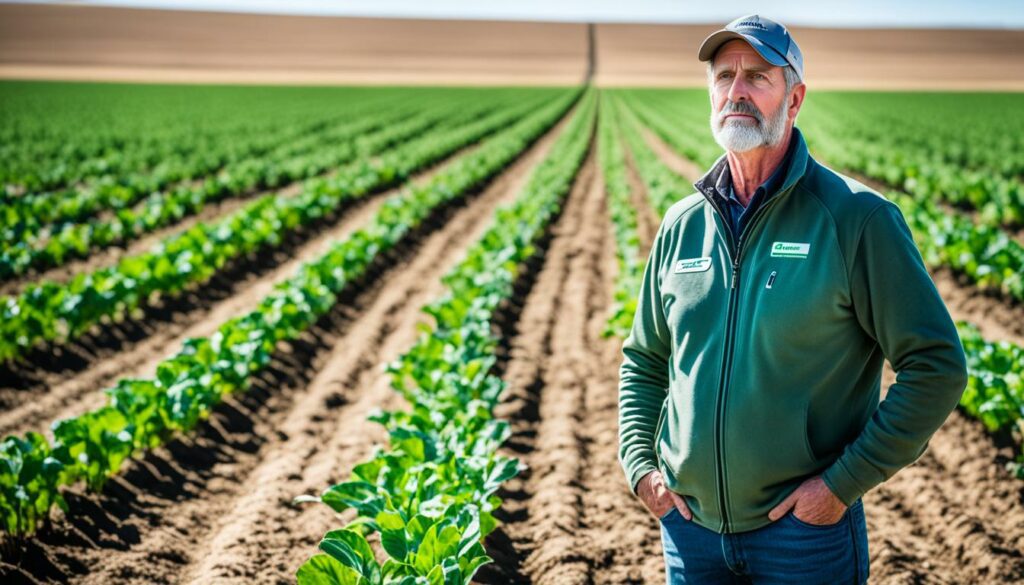
Climate FieldView™ stands out in farming today. It collects and analyses lots of farm data, helping farmers make smart choices. This tech tailors to each land piece, making sure every bit is used well. It guides farmers with its findings, cutting waste and making farming efficient.
Data is changing farming. With tech like blockchain and AI, farms can be more efficient. Blockchain helps track food and makes supply chains better. This means less fertiliser and more efficient farms, helping the planet.
| Technology | Benefit |
|---|---|
| Satellite Guidance Systems | Optimises land use, increases productivity per square foot |
| Strip-Tilling | Improves early plant growth through precise seed and fertiliser use |
| Engineered Water Control Systems | Makes more crops, recovers costs within two years |
Using this tech boosts not just crop yields but also makes farms more efficient and eco-friendly. Good farming, tech included, is key to feeding the world without harming the earth.
Improving how farms are run is key to using resources well and reducing risk. This, in turn, helps make more money. By carefully planning and checking things, I’ve discovered some top ways to make farm management better.
To manage resources well, start with clear goals. Research shows that writing down goals can lead to a 42% higher success rate. This is important for farms because it helps focus resources. My advice is to set up 10 key goals for the next three years to keep track of your progress.
It’s crucial to look at the profits of each part of the farm. By checking each area’s finances, like the animals or the crops, you can spot what’s making money and what’s not. This helps with the budget, making sure you’re spending wisely. Using tools like Excel can make this job easier.
| Enterprise | Total Income | Overhead Expenses | Variable Expenses | Net Profit |
|---|---|---|---|---|
| Re-stockers | $40,000 | $10,000 | $15,000 | $15,000 |
| Backgrounding | $35,000 | $8,000 | $12,000 | $15,000 |
| Commercial Stock | $50,000 | $12,000 | $18,000 | $20,000 |
Managing risk well is a big part of running a farm. By breaking down what each part of the farm is making and spending, you can see where you need to work harder. Plus, using digital tools to keep records means you have all the info for quick, smart decisions.
Doing things like planting crops close together can lower risks and raise yields. It helps the environment too by reducing erosion and controlling weeds. Using smart water systems can help save water and energy, which is good for the planet.
Growing crops that like the heat can also be smart. They can help you get better harvests. And by applying the right fertilisers, tested to suit your land, you keep the soil healthy for better growth.
Seasonal harvesting techniques help farmers work better. By harvesting in rhythm with the seasons, they collect crops on time. This reduces waste, improves the crop’s quality, and increases the amount of produce.
Agriculture in North America has changed a lot. In Colonial times, 90% of people worked in farming. Today, it’s just 11%, but farming is still huge. It feeds over 1 billion people and makes more than $1.3 trillion in food each year. Plus, nearly half of America and over half of Canada is used for farming. This shows how important farming is in these places.
Canada is great for growing cool-weather crops like beans and peas. It’s the top exporter of these foods. On the other hand, the United States grows lots of corn. This corn goes into more than 3,000 grocery items. So, farming techniques need to match the land for success.
| Country | Harvest Season | Key Crops | Notable Crops |
|---|---|---|---|
| Canada | June to November | Beans, Peas, Chickpeas, Lentils | Cool-Season Crops |
| United States | July to November | Corn, Soybeans, Wheat | Corn in over 3,000 products |
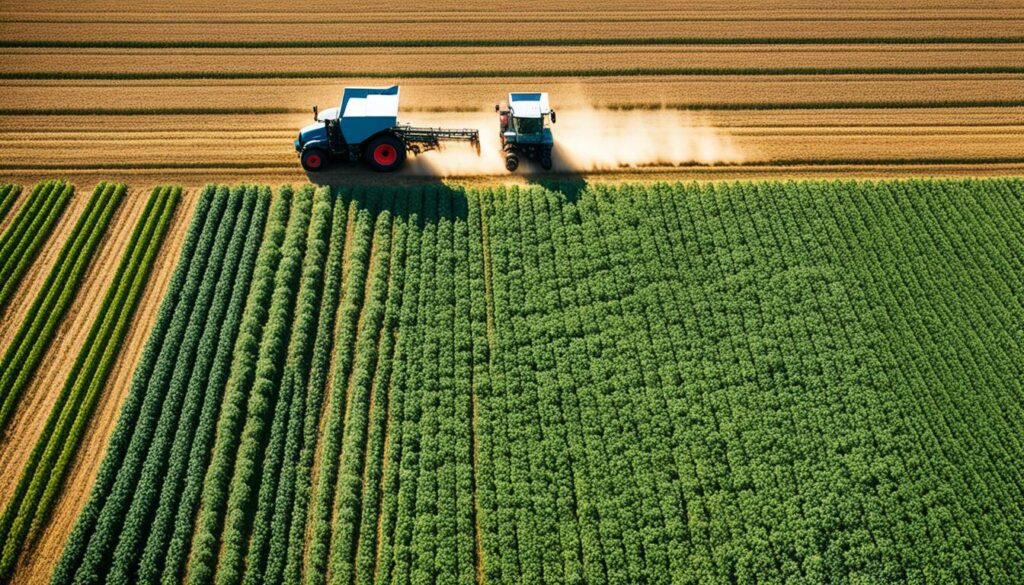
Over time, farming tools have greatly improved. Machines like the Stationary Threshing Machine and the Corn Picker in the past changed farming. Then, satellite technology in 1994 made farming even more efficient. It allows for careful planning and better results.
Farmers have to get their equipment ready all year for the harvest. This makes sure nothing goes wrong and they avoid delays. Keeping storage bins tidy is also important to stop crop damage. Dealing with weeds early can make the fields do better, leading to more crops.
Good record-keeping for money and taxes is also vital. It saves farmers time and lets them focus on farming. Working with lenders who understand farming can be very helpful. They give farmers support that meets their unique needs, helping them do well each season.
Using these tips for seasonal harvesting is key to making farms more productive. It ensures that farms can keep running well for a long time.
In farms, how well animals reproduce affects the farm’s success a lot. By working on making reproduction more effective, farmers can run their herds better. This leads to better quality herds and less money spent.
Having good reproduction is key for farms to make money. Choosing the right genetics, like focusing on the daughter pregnancy rate (DPR), can really help. A 1% rise in DPR means cows get pregnant 4 days earlier, improving their breeding cycles.
The quality of embryos is also affected by how long a follicle dominates and the level of progesterone. So, it’s important to watch and control these hormones. Better fertility means more milk and fewer problems getting pregnant, which can cause delays in giving birth and lead to selling cows sooner.
Coming up with good ways to mate animals is vital for better reproduction. Using fertility programs to get high 21-day pregnancy rates in good milking cows helps a lot. Also, adjusting progesterone levels before insemination can boost results.
Finding when cows are ready for mating efficiently is crucial. It works well for younger or less milk-producing cows. But, it’s harder for cows that produce a lot of milk. Keeping cows well-fed and in good shape after they give birth is very important for getting them pregnant again.
There are tools that tell farmers which reproduction methods are the best for saving money and having good results. These help make sure the choices are both good for the farm and not too expensive. They show that investing in reproduction brings in more money and keeps the farm going for a long time.
Factors like choosing the right genetics and using good fertility plans are critical for farms to do well. They help farmers earn more and keep their farms running for the future.
So, using the right methods for mating can really make a farm more efficient and profitable. This is good not just for making money but also for making sure farms can keep producing well.
Using new ideas in farming is key to keep growing and sustainable. Agriculture gets better by using the latest tech and checking how it compares to the best. This isn’t just about catching up; it’s about leading the way to a farming future that’s smarter and more efficient. In places like Europe and North America, six out of ten farmers are starting to use or plan to use advanced technology in their farming within the next couple of years. This change shows a big move towards farming driven by technology.
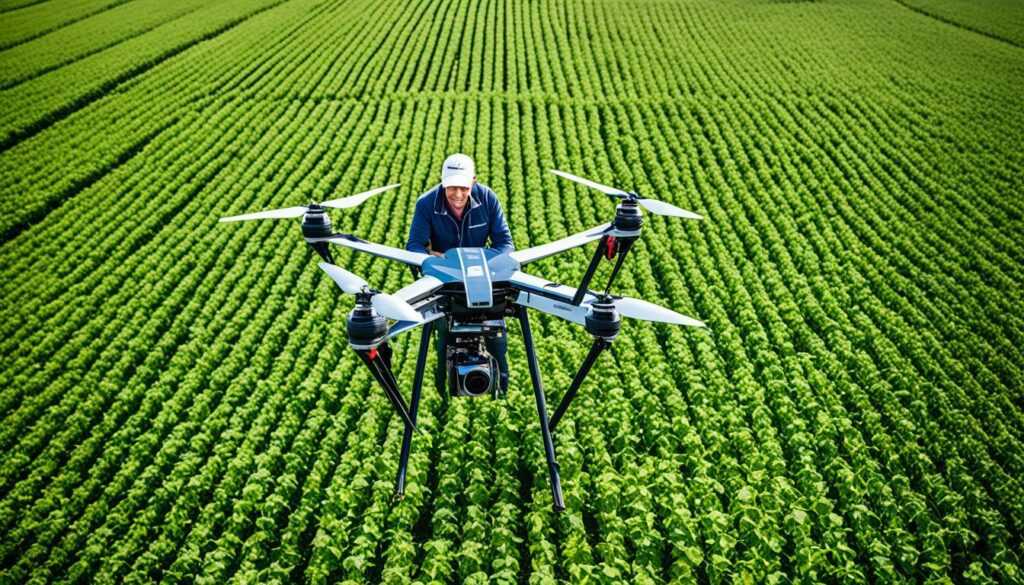
Farming is attracting a lot of new investment, with over $18 billion put into farming technology in 2021 alone. This is nearly 40% more than what was invested eight years ago. Farmers are looking at precise and digital farming tools, making it easier to look after their plants and animals. Artificial intelligence helps in guessing how big the harvest will be and spotting pests early. Also, switching to electric power can save money by not using as much diesel, which is good for the budget and the planet.
Comparing farming methods with the best is key to keep getting better. This helps farmers see where they’re doing well and where they could improve. For example, the biggest farms are more ready to use advanced technology, with 81% being interested. This is much higher than the smaller farms with only 36% looking into it. By seeing where they stand next to top farmers, they push themselves to be just as good or even better. Smart farming tools play a big role here, cutting down on the need for harmful chemicals. This way, farms can use the planet’s resources in the best way for bigger harvests.
Boosting farm efficiency across seasons needs a smart plan. It ensures farms stay productive all year. By looking at real cases, we see year-long benefits from smart strategies. Let’s dive into these perks.
In the last ten years, farms have been growing crops all year, especially in greenhouses. This way, they can grow a variety of crops anytime. This led to a 30% jump in crop types. It’s not just about more crops. It also means spending less energy for each crop. Energy costs dropped by 25%. So, it’s good for the planet and the pocket.
Using smart ways to fight pests has also helped. There’s been a 15% drop in the crops pests ruin. More farming all year round means more work for people. This has caused a 20% increase in job opportunities in farming areas. With these approaches, farms are making 35% more crops for every acre, which is a boost for their incomes.
Looking at some examples, countries that farm all year use less imported food. This makes their food supply more secure. They’ve managed to produce 40% more of their food locally. Plus, they’re saving water and using their land better. There’s a 50% drop in waste land and 20% less water used, helping the environment.
The Greenbelt Microgreens is a great example. They’ve cut down their carbon footprint by 45%. This is thanks to needing less transport for their produce. And people want this kind of food more now. The demand for locally grown food has gone up by 25%. These real cases show why year-long farming is key.
In a nutshell, making farms work all year is good for everyone. It helps the environment, brings more jobs, and boosts the economy. It’s a win-win for farming and the world around us.
Maximising yields means making the most of what plants can do. This involves using precise farming methods and improving planting practices. Doing this helps farmers increase how much they grow and gets the most out of their fields.
Research, like in *Crop Sci.* 2015, shows how crucial it is to find the parts of plants that deal well with drought and heat. Also, studies, including the one in *Eur. J. Agron.* 2017, point to new ways to collect data to understand why some crops don’t grow as much as they could.

Changes in weather make things more complicated for plants. The work in *Global Chang. Biol.* 2019 tells us that using computer models helps. These models can help make crops grow better on farms. Working together, companies and the government help make this happen.
The FAO says we need to grow more food by 2050. Science, like in *J. Exp. Bot.* 2011, is looking for ways to make crops produce more food, without falling over. This is why targeting how crops grow and using better management matters a lot.
Climate change is a big challenge, as talked about in *Engineering 2018*. By focusing on specific plant genes, like in *J. Exp. Bot.* 2016, we can help crops survive crazy weather. This all-around effort helps plants use their full potential. So, we get more food and help farming be better for the planet.
| Study | Focus | Key Findings |
|---|---|---|
| Crop Sci. 2015 | Wheat QTL Regions | Adaptation to drought and heat stress |
| Eur. J. Agron. 2017 | Yield Gap Explaining Factors | Alternative data collection approaches |
| Global Chang. Biol. 2019 | Climate Change Impact | Adaptation for wheat protein |
| J. Exp. Bot. 2011 | Raising Yield Potential | Optimising partitioning to grain maintaining lodging resistance |
| Engineering 2018 | Climate Change Adaptation | Improved yield and adaptation |
Maximising agricultural productivity starts with building soil resilience. The winter of 2019-20 in the UK saw a record level of rain – 470 mm in just three months. This weather showed us why it’s vital to have strong, resilient soil. It can handle harsh weather like heavy rain well and avoid compaction and draining problems.
To keep crops healthy, good soil structure is a must. Adding organic matter improves the soil’s physical traits, making it more aerated and easier for roots to grow. Organic carbon is amazing at holding water, which is key for dealing with droughts. Practices like using cover crops and avoiding tilling can improve the soil and help farming be more productive.
Keeping soil structures strong helps water soak in better. This way, crops get the moisture they need, whether it’s from a lot of rain or in droughts. When it rains a lot or is very wet, planting crops late can cause problems with weed control before they grow. But planting deep-rooted perennials can help crops absorb water better and stop soil from washing away.
Research shows that good soil with cover always under it lets less water wash the soil nutrients away. This means the yields are more stable and better. I have seen that using farming methods focused on keeping the soil healthy helps farmers earn more. So, making soil that can handle tough weather is key to farming well in the long run.
It’s vital to cut nitrous oxide emissions on farms. These practices are essential because nitrous oxide is much more potent than carbon dioxide. We can tackle this by using several methods.
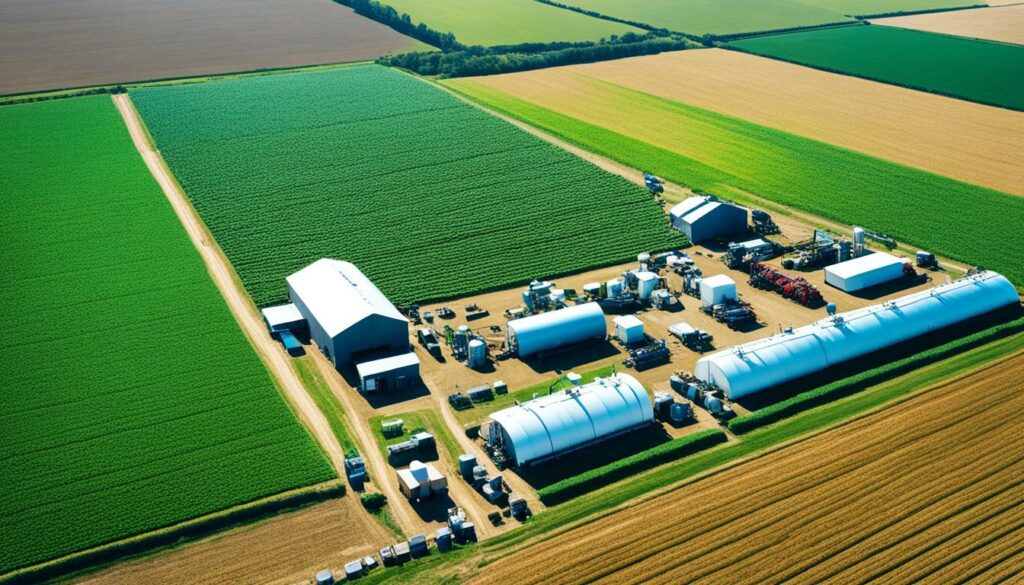
Precision fertilisation is a key approach. By matching nitrogen fertilisers with a crop’s needs, we lower nitrous oxide levels. It’s like giving plants what they need, when they need it.
This includes spreading out fertiliser applications, especially as plants grow fast. Doing this makes the fertiliser more useful to plants and reduces waste. It’s an eco-friendly way to farm.
Another helpful method is to delay adding fertiliser until the plants truly start growing. This can mean less nitrogen lost to the air. There are also special fertilisers that don’t turn into harmful nitrates too quickly.
So, by farming smartly, we cut down nitrous oxide. This approach also improves how nitrogen is used in the soil. It’s better for the environment and the land.
Agriculture releases approximately 80% of Australia’s nitrous oxide emissions, showing why these steps are so important.
Using tools to decide when we need more nitrogen, like PSNT, can be very smart. They help avoid using too much, which could become nitrous oxide.
Planting legumes in between crops is also a good plan. These plants add their own nitrogen to the soil. This means we don’t need to use as much artificial fertiliser. Less digging also helps keep nitrous oxide down.
| Strategy | Benefit |
|---|---|
| Precision Fertilisation | Reduces excess nitrogen, enhancing efficiency. |
| Delayed Nitrogen Application | Increases plant uptake, reducing emissions. |
| Nitrification Inhibitors | Slows conversion of nitrogen to nitrates. |
| Legume Crop Integration | Natural nitrogen fixation. |
| Minimum Tillage | Prevents soil compaction and disruption. |
These farming practices are crucial for lessening nitrous oxide. They also help achieve broader environmental goals. They’re key for a sustainable future without harming the earth.
I’m dedicated to improving our farms with the help of Agrii’s plan. Their approach tackles big issues while making farms more productive and sustainable in the UK. The plan uses new tech and eco-friendly methods to ensure farms prosper for the long haul.
Agrii’s approach is already bringing in higher yields, going above the national average. A big focus is on using nitrogen more efficiently to cut down on harmful gas. This method could reduce 75% of these gases, helping the planet and crop growth.
Agrii is looking ahead, worried about less money for farms until 2027. They want to use new breeding and tech to boost farms and meet what consumers need. They also want to improve soil so farms can work better all year round.
Agrii’s Five Point Plan helps prepare for these changes, making farms strong and profitable. They encourage new ideas through the Agrii Innovation award. With these efforts, I believe farming can do well, being productive and eco-friendly.
The journey to maximising seasonal farm efficiency shows us several important steps. Each step is crucial for managing farms well in today’s world. This includes using sustainable practices and new technology. These, joined with smart farm management, create a strong foundation for any farm. The good effects of these methods go far, like helping the environment and keeping the farm going strong for years to come.
Good farm management means knowing important financial signs. The Rate of Return On Farm Assets (ROA) is key. It measures how profitable your assets are. A high ROA, over 8%, is very good. If ROA is under 4%, there’s reason to worry. The Rate of Return On Farm Equity (ROE) is also vital. It looks at the returns compared to the farm’s invested equity. Aim for over 10% to be doing well. If it’s under 3%, that’s a bad sign.
There’s also the operating profit margin ratio to consider. It measures how well you turn farm revenue into profit. A ratio above 25% is great, but under 15% is a concern. Another key is the asset turnover ratio, showing how efficiently you’re making money. A number above 45% is the goal. Less than 30% means you should take a closer look at your farm operation. These measures show the value of looking at the big picture. It ensures not just temporary gains but long-lasting success.
Bringing these insights together creates a clear path to making farms more efficient and successful. By using new tech, supporting sustainable ways, and managing well, farmers can do better in changing markets. Following these steps leads to higher farm profits. It also helps build a farm sector that can tackle future challenges head on.
Seasonal farm efficiency means using the farming season’s natural cycles for the best results. It focuses on using practices that are kind to the environment. These include managing resources well and doing things at the right time. The goal is to produce more while causing less harm.
Sustainable farming helps cut big pollution from agriculture. It keeps the soil healthy and the land productive for the long term. By following these practices, we can meet the growing need for eco-friendly food. We also stay in line with global efforts to be greener.
There are many eco-friendly ways to lower farm emissions. Actions like using less fertiliser and certain treatments can help. They cut down on gases that harm the planet. This makes our farms more sustainable.
To get the best crops, look after the soil and feed your plants well. Mix up what you grow in the fields and keep the ground in good shape. This investment in the soil pays off with healthier crops and bigger harvests.
Farm tech lets farmers gather and study lots of data. This smart tech helps make better choices. It leads to using resources better, making crops grow well, and overall, yields getting higher.
Good farm management means putting resources in the right places and planning ahead for problems. By doing this, farmers can earn more, grow better crops, and keep their farms going strong for a long time.
Harvesting in tune with the seasons reduces waste and gets better products. It makes sure the harvest happens at just the right time. This boosts the farm’s working smoothness and how much gets done.
Better animal breeding means less waste and better stuff to sell. It also helps in keeping with pollution limits. Plus, it makes the farm do more, better.
New tech and following the best ways improve how farms work. They show what can be done better, making farms more effective and green.
Getting the most out of each season saves money, makes more food, and is good for the planet. It’s a winning strategy that works all year long.
To bridge this gap, farmers need to plan better, use the latest methods, and manage farms closely. Doing these things can really fulfil a crop’s potential, leading to bigger harvests and better farm results.
Strong soil is key for good crops. It lets the plants get more water and stay healthy. Healthy soil fights off bad weather and keeps the farm going strong.
To cut these bad gases, farm wisely with precision fertilising and special treatments. These steps improve how we use nitrogen, making farms both greener and more efficient.
Agrii wants to boost farms with smart tech, keep the good production going, and care for nature. Their plan helps farms deal with changes and use high-tech ways, ensuring they last and do well for the future.